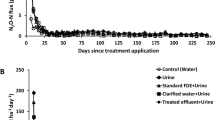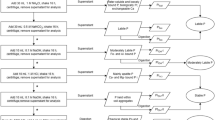Abstract
Purpose
Land application of farm dairy effluent (FDE) to pasture soils is the preferred practice in New Zealand. Recently, a new FDE treatment technology has been developed to recycle the water for washing the yard Cameron and Di (J Soils Sediments 2018). Here we report a lysimeter study to compare the leaching losses of Escherichia coli, phosphorus (P), and nitrogen (N) and emissions of greenhouse gases from the treated FDE compared with the untreated original FDE.
Materials and methods
Lysimeters were collected from a Balmoral silt loam soil (Typic Dystrudept, USDA) and installed in a field trench facility. Treatments included (1) treated effluent (TE), (2) a mixture of TE and recycled water (M), (3) untreated original FDE (FDE), and (4) water as control. The effluents were applied at a surface application rate of 24 mm on each lysimeter in May and again in September 2017. Measurements included leaching losses of E. coli, total phosphorus (TP), dissolved reactive phosphorus (DRP), total mineral nitrogen (TN), ammonium-N (NH4+-N), and nitrate-N (NO3−-N); emissions of nitrous oxide (N2O), carbon dioxide (CO2), and methane (CH4); herbage yield; and N uptake.
Results and discussion
The results showed that E. coli, TP, and DRP leaching losses from the TE were 1.31 × 1010 cfu/ha, 0.26 kg P/ha, and 0.009 kg DRP/ha and from M treatments were 6.96 × 108 cfu/ha, 0.18 kg P/ha, and 0.004 kg DRP/ha, respectively, which were significantly (P < 0.05) lower than those from the FDE which were 4.21 × 1010 cfu/ha, 1.75 kg P/ha, and 0.034 kg DRP/ha, respectively. There were no significant differences in NO3−-N leaching losses amongst the different forms of effluents. There were no significant differences in total N2O, CO2 emissions, and CH4 uptakes from the different effluents (P < 0.05). Herbage dry matter yields and N uptakes were also similar in the different effluent-treated lysimeters.
Conclusions
Results from this research indicate that land application of the treated effluents (TE) or a mixture of TE plus clarified water (M) would result in significant environmental benefits by reducing E. coli and P leaching without increasing greenhouse gas emissions.






Similar content being viewed by others
References
Cameron KC, Di HJ (2004) Nitrogen leaching losses from different forms and rates of farm effluent applied to a Templeton soil in Canterbury, New Zealand. N Z J Agric Res 47:429–437
Cameron KC, Di HJ (2018) A new method to treat farm dairy effluent to produce clarified water for recycling and to reduce environmental risks from the land application of effluent. J Soils Sediments (this issue)
Cameron KC, Smith NP, McLay CDA, Fraser PM, McPherson RJ, Harrison DF, Harbottle P (1992) Lysimeters without edge flow: an improved design and sampling procedure. Soil Sci Soc Am J 56:1625–1628
Dai Y, Di HJ, Cameron KC, He JZ (2013) Effects of nitrogen application rate and a nitrification inhibitor dicyandiamide on methanotroph abundance and methane uptake in a grazed pasture soil. Environ Sci Pollut Res Int 20:8680–8689
Dairy NZ (2018) New Zealand Dairy statistics. Dairy New Zealand, Hamilton, pp 2016–2017
Di HJ, Cameron KC (2002a) Nitrate leaching and pasture production from different nitrogen sources on a shallow stoney soil under flood-irrigated dairy pasture. Soil Res 40:317–334
Di HJ, Cameron KC (2002b) Nitrate leaching in temperate agroecosystems: sources, factors and mitigating strategies. Nutr Cycl Agroecosyst 64:237–256
Di HJ, Cameron KC, Moore S, Smith NP (1998a) Nitrate leaching from dairy shed effluent and ammonium fertiliser applied to a free-draining pasture soil under spray or flood irrigation. N Z J Agric Res 41:263–270
Di HJ, Cameron KC, Moore S, Smith NP (1998b) Nitrate leaching and pasture yields following the application of dairy shed effluent or ammonium fertilizer under spray or flood irrigation: results of a lysimeter study. Soil Use Manag 14:209–214
Di HJ, Cameron KC, Moore S, Smith NP (1999) Contributions to nitrogen leaching and pasture uptake by autumn-applied dairy effluent and ammonium fertilizer labeled with 15N isotope. Plant Soil 210:189–198
Di HJ, Cameron KC, Sherlock RR (2007) Comparison of the effectiveness of a nitrification inhibitor, dicyandiamide, in reducing nitrous oxide emissions in four different soils under different climatic and management conditions. Soil Use Manag 23:1–9
Ebina J, Tsutsui T, Shirai T (1983) Simultaneous determination of total nitrogen and total phosphorus in water using peroxodisulfate oxidation. Water Res 17:1721–1726
Hutchinson GL, Mosier AR (1981) Improved soil cover method for field measurement of nitrous oxide fluxes Improved soil cover method for field measurement of nitrous oxide fluxes. Soil Sci Soc Am J 45:311–316
Laubach J, Heubeck S, Pratt C, Woodward K, Guieysse B, Van Der Weerden T, Chung M, Shilton A, Craggs R (2015) Review of greenhouse gas emissions from the storage and land application of farm dairy effluent. N Z J Agric Res 58:203–233
Li J, Shi Y, Luo J, Zaman M, Houlbrooke D, Ding W, Ledgard S, Ghani A (2014) Use of nitrogen process inhibitors for reducing gaseous nitrogen losses from land-applied farm effluents. Coop J Int Soc Soil Sci 50:133–145
Li J, Luo J, Shi Y, Houlbrooke D, Wang L, Lindsey S, Li Y (2015) Nitrogen gaseous emissions from farm effluent application to pastures and mitigation measures to reduce the emissions: a review. N Z J Agric Res 58:339–353
Maillard É, Angers DA (2014) Animal manure application and soil organic carbon stocks: a meta-analysis. Glob Chang Biol 20:666–679
McLeod M, Aislabie J, McGill A, Rhodes P, Carrick S (2014) Leaching of Escherichia coli from stony soils after effluent application. J Environ Qual 43:528–538
Ministry for the Environment (2018) New Zealand's greenhouse gas inventory 1990-2015. Ministry for the Environment, Wellington Vol publication number: ME1309
Ohno T, Zibilske LM (1991) Determination of low concentrations of phosphorus in soil extracts using malachite green. Soil Sci Soc Am J 55:892–895
Rochette P (2011) Towards a standard non-steady-state chamber methodology for measuring soil N2O emissions. Anim Feed Sci Technol 166 167:141–146
Toor G, Condron L, Di H, Cameron K, Sims J (2004) Assessment of phosphorus leaching losses from a free draining grassland soil. Nutr Cycl Agroecosyst 69:167–184
Toor GS, Condron LM, Di HJ, Cameron KC, Sims JT (2010) Impact of farm-dairy effluent application on the amounts and forms of phosphorus loss by leaching from irrigated grassland. N Z J Agric Res 47:479–490
van der Weerden TJ, Cox N, Luo J, Di HJ, Podolyan A, Phillips RL, Saggar S, de Klein CAM, Ettema P, Rys G (2016) Refining the New Zealand nitrous oxide emission factor for urea fertiliser and farm dairy effluent. Agric Ecosyst Environ 222:133–137
Vogeler I, Beukes P, Burggraaf V (2013) Evaluation of mitigation strategies for nitrate leaching on pasture-based dairy systems. Agric Syst 115:21–28
Wang H, Magesan GN, Bolan NS (2004) An overview of the environmental effects of land application of farm effluents. N Z J Agric Res 47:389–403
Acknowledgements
We would like to thank Steve Moore, Trevor Hendry, Carole Barlow, and Roger Atkinson of Lincoln University for the technical support.
Funding
Ravensdown Ltd. and Lincoln University provided funding for this research.
Author information
Authors and Affiliations
Corresponding author
Additional information
Responsible editor: Zhihong Xu
Publisher’s note
Springer Nature remains neutral with regard to jurisdictional claims in published maps and institutional affiliations.
Rights and permissions
About this article
Cite this article
Wang, X.M., Di, H.J., Cameron, K.C. et al. Effect of treated farm dairy effluent on E. coli, phosphorus and nitrogen leaching and greenhouse gas emissions: a field lysimeter study. J Soils Sediments 19, 2303–2312 (2019). https://doi.org/10.1007/s11368-018-02228-9
Received:
Accepted:
Published:
Issue Date:
DOI: https://doi.org/10.1007/s11368-018-02228-9




